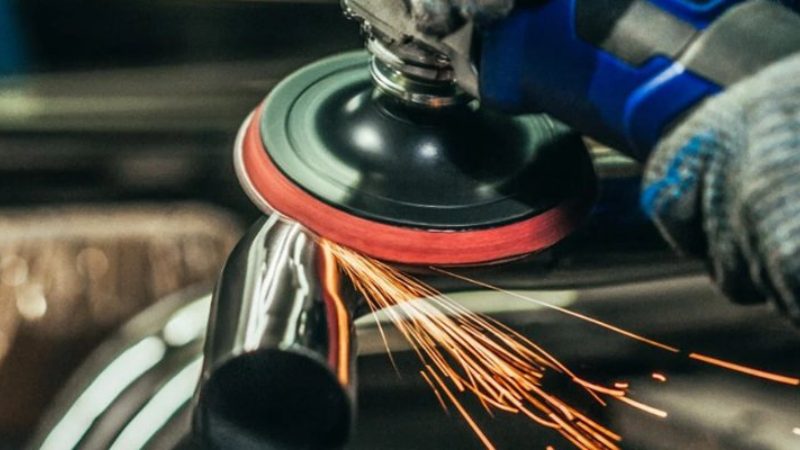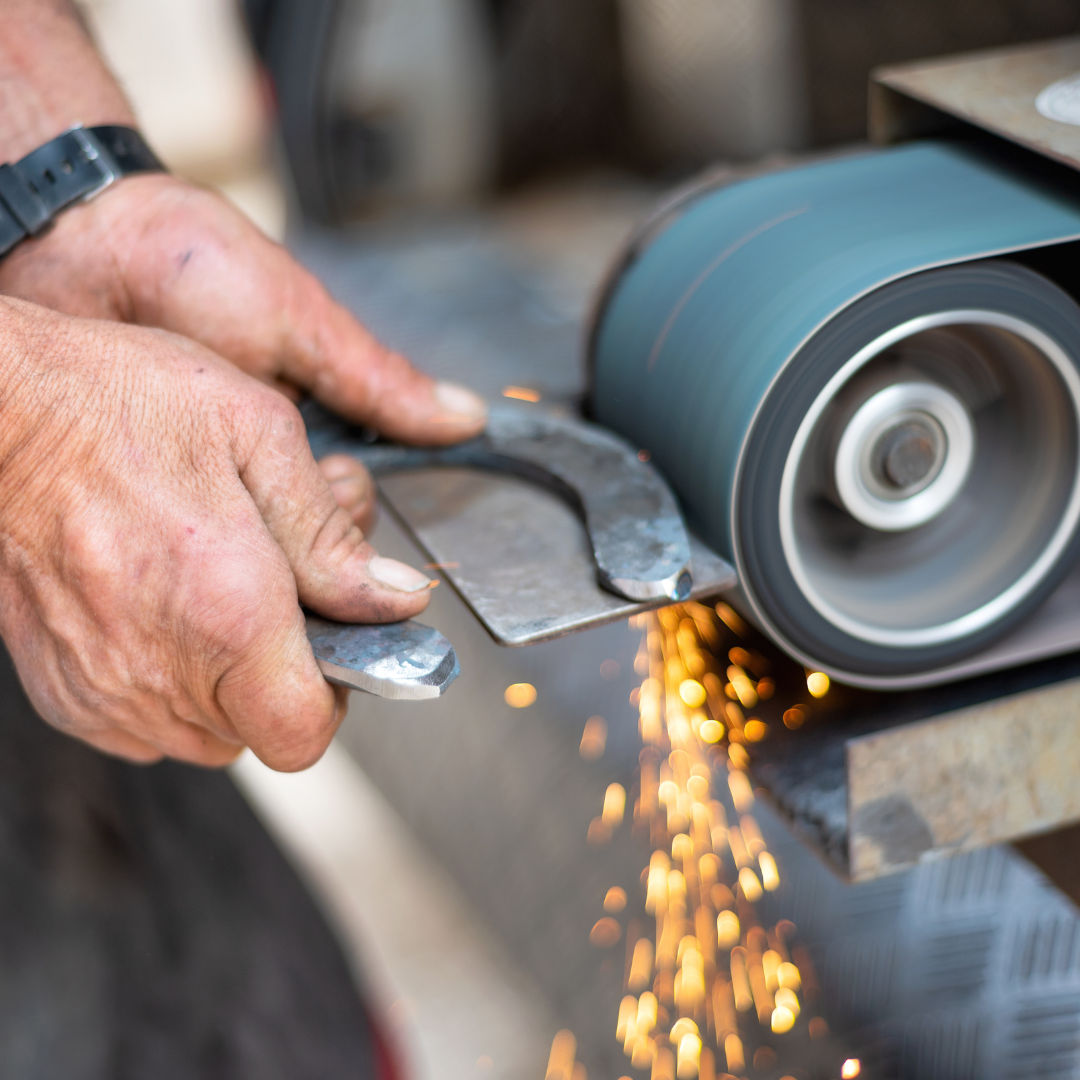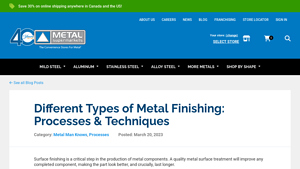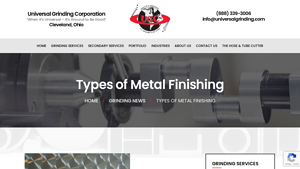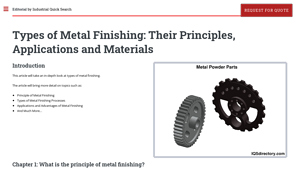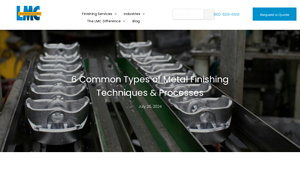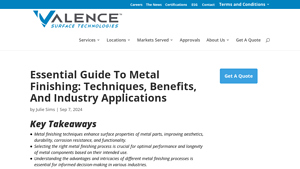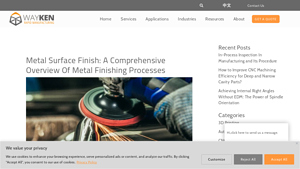Metal Finishing Techniques Guide: Type, Cost, Top List…
Introduction: Navigating the Global Market for metal finishing techniques
In today’s increasingly competitive landscape, sourcing the right metal finishing techniques is a pivotal challenge for international B2B buyers. The demand for high-quality metal components is not only driven by aesthetic considerations but also by the need for enhanced durability, corrosion resistance, and functionality. This guide serves as a comprehensive resource, delving into various metal finishing methods such as electroplating, anodizing, and powder coating. It also addresses their specific applications across industries, helping buyers understand which techniques best meet their product requirements.
Navigating the complexities of metal finishing can be daunting, especially for businesses operating in diverse regions such as Africa, South America, the Middle East, and Europe, including key markets like Germany and Vietnam. This guide empowers B2B buyers by providing actionable insights into supplier vetting processes, cost considerations, and performance metrics. By highlighting the critical factors that influence metal finishing choices, we equip decision-makers with the knowledge necessary to make informed purchasing decisions.
Ultimately, this guide aims to streamline the sourcing process, reduce waste, and enhance product quality, ensuring that your business remains competitive in a global market where precision and reliability are paramount.
Understanding metal finishing techniques Types and Variations
| Type Name | Key Distinguishing Features | Primary B2B Applications | Brief Pros & Cons for Buyers |
|---|---|---|---|
| Electroplating | Involves depositing metal ions onto a substrate using electricity. | Automotive, electronics, and jewelry. | Pros: Excellent corrosion resistance; enhances surface properties. Cons: Requires precise control; longer processing times. |
| Electroless Plating | Chemical deposition without electricity; often used for even coatings. | Aerospace, medical devices, and industrial applications. | Pros: Uniform coating on complex shapes; no need for electrical setup. Cons: Higher material costs; requires careful chemical handling. |
| Anodizing | Electrochemical process that forms a protective oxide layer, especially on aluminum. | Construction, automotive, and consumer goods. | Pros: Increases corrosion resistance; improves aesthetic appeal. Cons: Limited to non-ferrous metals; specific to aluminum and titanium. |
| Powder Coating | Uses electrostatic charge to apply powder particles, then cured with heat. | Appliances, automotive parts, and outdoor furniture. | Pros: Durable finish; available in various colors. Cons: Requires specialized equipment; potential for overspray waste. |
| Polishing/Buffing | Mechanical process to enhance surface smoothness and shine. | Manufacturing of components requiring high aesthetics, such as jewelry and medical devices. | Pros: Improves appearance and hygiene; relatively quick process. Cons: May not remove deep imperfections; can be labor-intensive. |
What Are the Key Characteristics of Electroplating?
Electroplating is a widely used metal finishing technique that involves immersing a substrate in a solution containing metal ions, which are deposited onto the surface via an electric current. This method is particularly effective for enhancing corrosion resistance and improving the aesthetic quality of parts. B2B buyers should consider the specific requirements of their applications, as electroplating can require significant setup and monitoring to ensure quality and uniformity. Industries like automotive and electronics frequently utilize electroplating for its durability and functional benefits.
How Does Electroless Plating Differ from Electroplating?
Electroless plating is unique because it relies on a chemical reaction rather than electricity to deposit metal onto a substrate. This technique is advantageous for coating complex shapes and components that are difficult to reach with traditional electroplating. B2B buyers in aerospace and medical sectors often prefer electroless plating due to its uniform coating capabilities and ability to enhance solderability. However, the higher cost of materials and the need for careful chemical management are essential considerations when selecting this method.
Why Choose Anodizing for Aluminum and Non-Ferrous Metals?
Anodizing is an electrochemical process specifically designed for aluminum and certain non-ferrous metals, creating a protective oxide layer that enhances corrosion resistance and aesthetic appeal. It is particularly suitable for industries such as construction and automotive, where durability and appearance are critical. B2B buyers should evaluate the specific metal types and desired finishes, as anodizing is limited to specific materials. The controlled oxidation process also allows for customization in color and texture, adding value to the finished product.
What Are the Benefits of Powder Coating?
Powder coating is a modern finishing technique that involves applying a dry powder to metal surfaces, which is then cured under heat to form a hard, durable finish. This method is popular in industries such as appliances and automotive due to its resistance to chipping, scratching, and fading. B2B buyers should consider the availability of specialized equipment and the potential for overspray waste when choosing powder coating. The variety of colors and finishes available also allows for greater customization in product design.
When Should You Consider Polishing or Buffing?
Polishing and buffing are mechanical processes aimed at enhancing the smoothness and shine of metal surfaces. This technique is especially relevant in industries where aesthetics are paramount, such as jewelry manufacturing and medical devices. B2B buyers must weigh the benefits of improved appearance and hygiene against the labor intensity and potential limitations in addressing deeper surface imperfections. Understanding the specific requirements of the intended application can guide buyers in selecting the most effective finishing method.
Key Industrial Applications of metal finishing techniques
| Industry/Sector | Specific Application of Metal Finishing Techniques | Value/Benefit for the Business | Key Sourcing Considerations for this Application |
|---|---|---|---|
| Automotive | Corrosion resistance coatings for chassis | Enhances durability and lifespan of vehicles, reducing maintenance costs | Ensure compliance with international standards and regulations |
| Aerospace | Anodizing for lightweight components | Improves weight-to-strength ratio, essential for fuel efficiency | Look for suppliers with aerospace certifications and experience |
| Electronics | Electroless plating for circuit boards | Increases conductivity and reliability of electronic components | Evaluate the quality of plating baths and turnaround times |
| Medical Devices | Polishing for surgical instruments | Ensures hygiene and precision, critical for patient safety | Source from suppliers with ISO certifications and cleanroom capabilities |
| Construction | Powder coating for metal structures | Provides aesthetic appeal and corrosion protection, extending service life | Assess the durability of coatings and environmental compliance |
How Are Metal Finishing Techniques Applied in the Automotive Sector?
In the automotive industry, metal finishing techniques such as corrosion resistance coatings are vital for protecting the vehicle’s chassis. These coatings prevent rust and degradation, significantly enhancing the durability and lifespan of vehicles. For international buyers, particularly in regions with harsh climates, sourcing high-quality coatings that meet stringent international standards is crucial. Cost-effectiveness and long-term maintenance savings also play a significant role in decision-making.
What Role Do Metal Finishing Techniques Play in Aerospace Applications?
Aerospace components often require anodizing to improve their weight-to-strength ratio. This electrochemical process enhances corrosion resistance while ensuring that parts remain lightweight, which is essential for fuel efficiency. Buyers from the aerospace sector must prioritize suppliers with relevant certifications and a proven track record in delivering high-quality finishes that meet rigorous safety and performance standards.
How Is Electroless Plating Used in the Electronics Industry?
In the electronics sector, electroless plating is widely utilized for circuit boards to enhance conductivity and reliability. This technique allows for uniform metal deposition, which is crucial for the performance of electronic components. For international buyers, assessing the quality of plating baths and the supplier’s ability to meet delivery schedules is essential to ensure minimal disruption in production processes.
Why Is Polishing Important for Medical Devices?
Polishing techniques are critical in the medical device industry, especially for surgical instruments. A polished surface ensures hygiene and precision, which are paramount for patient safety. Buyers should focus on sourcing from suppliers with ISO certifications and advanced cleanroom capabilities to guarantee the highest standards of cleanliness and quality in their medical products.
How Does Powder Coating Benefit the Construction Industry?
In construction, powder coating is frequently applied to metal structures to provide aesthetic appeal and corrosion protection. This finishing technique significantly extends the service life of construction materials, making it a valuable investment. Buyers should evaluate the durability of coatings and ensure that their suppliers comply with environmental regulations to mitigate any potential risks associated with chemical runoff.
3 Common User Pain Points for ‘metal finishing techniques’ & Their Solutions
Scenario 1: Difficulty in Selecting the Right Metal Finishing Technique for Specific Applications
The Problem: B2B buyers often struggle to select the most suitable metal finishing technique for their unique applications. For example, a manufacturer producing components for the automotive industry may require finishes that enhance both aesthetic appeal and corrosion resistance. However, the wide array of options—such as electroplating, anodizing, or powder coating—can lead to confusion. This uncertainty can result in selecting an inappropriate technique, leading to compromised product quality, increased costs, and potential delays in delivery schedules.
The Solution: To address this challenge, buyers should begin by clearly defining the requirements of their finished product. This includes understanding the operational environment, desired durability, aesthetic preferences, and compliance with industry standards. Engaging in a consultative process with metal finishing experts can provide invaluable insights into the strengths and weaknesses of various techniques. Furthermore, conducting small-scale trials or pilot runs with different finishes can help assess which technique best meets the specific needs of the application. Documenting results from these trials will allow for informed decision-making and ultimately lead to improved efficiency in the production process.
Scenario 2: Managing Costs and Budget Constraints in Metal Finishing Projects
The Problem: Many B2B buyers face budget constraints that make it challenging to implement high-quality metal finishing solutions. This is particularly relevant for small to mid-sized manufacturers in regions with limited access to advanced technologies. As a result, they may resort to low-cost finishes that fail to provide adequate protection or aesthetic quality, leading to increased long-term costs due to product failures or customer dissatisfaction.
The Solution: To effectively manage costs while ensuring quality, buyers should adopt a value-based approach to sourcing metal finishing services. This involves evaluating potential suppliers not just on price but also on their reputation, quality assurance processes, and the longevity of their finishes. It may also be beneficial to explore local suppliers who can offer competitive pricing without the additional costs associated with international shipping. Additionally, implementing a phased approach to metal finishing, where only critical components receive high-end finishes initially, allows for gradual investment without overwhelming budget constraints. This strategy enables manufacturers to assess performance and user feedback before committing to broader applications of costly finishes.
Scenario 3: Ensuring Consistent Quality Across Multiple Batches of Finished Products
The Problem: Consistency in quality is a common pain point for B2B buyers who require large volumes of finished metal components. Variability in the finishing process can lead to differences in appearance, corrosion resistance, and functionality between batches. This inconsistency not only affects product reliability but can also damage customer trust and brand reputation.
The Solution: To mitigate quality variability, buyers should establish stringent quality control protocols at every stage of the metal finishing process. This includes specifying clear standards for surface preparation, finishing techniques, and post-finishing inspections. Collaborating with suppliers to develop a comprehensive quality assurance plan can also help ensure that every batch meets established criteria. Implementing technologies such as automated monitoring systems during the finishing process can provide real-time data on quality metrics, allowing for immediate adjustments if deviations occur. Regular audits and feedback sessions with finishing partners will further enhance communication and ensure that quality remains a top priority throughout the production cycle.
Strategic Material Selection Guide for metal finishing techniques
What Are the Key Properties of Common Materials Used in Metal Finishing Techniques?
When selecting materials for metal finishing techniques, it’s essential to consider their inherent properties that influence product performance. Below, we analyze four common materials: Aluminum, Steel, Copper, and Zinc, focusing on their properties, pros and cons, impact on applications, and specific considerations for international B2B buyers.
Aluminum: A Lightweight and Corrosion-Resistant Option
Aluminum is known for its excellent corrosion resistance and lightweight nature, making it suitable for various applications, especially in aerospace and automotive industries. It can withstand moderate temperatures and pressures, which is beneficial for components exposed to varying environmental conditions.
Pros: Aluminum is highly durable and resistant to corrosion, which extends the lifespan of finished products. Its lightweight nature also reduces shipping costs and improves fuel efficiency in transportation applications.
Cons: The initial cost of aluminum can be higher than other metals, and its manufacturing complexity may require specialized equipment and processes, such as anodizing.
Impact on Application: Aluminum’s compatibility with various media makes it ideal for applications requiring thermal conductivity, such as heat exchangers.
Considerations for International Buyers: Buyers in regions like Europe and the Middle East must ensure compliance with standards such as EN and ASTM for aluminum products, as well as consider local preferences for specific aluminum alloys.
Steel: The Versatile Workhorse of Metal Finishing
Steel is one of the most widely used metals in manufacturing due to its strength and versatility. It offers good corrosion resistance, particularly when treated with coatings or finishes.
Pros: Steel is durable and can be produced at a relatively low cost. It also has excellent mechanical properties, making it suitable for heavy-duty applications.
Cons: Steel is prone to corrosion if not properly finished, which can lead to increased maintenance costs. Additionally, its weight may not be ideal for applications where lightweight materials are preferred.
Impact on Application: Steel’s compatibility with various finishing techniques, such as galvanizing and powder coating, enhances its suitability for construction and automotive applications.
Considerations for International Buyers: Buyers must be aware of compliance with international standards like ASTM and DIN, especially regarding the grades of steel being used for specific applications.
Copper: The Conductive Choice for Specialized Applications
Copper is renowned for its excellent electrical and thermal conductivity, making it a preferred choice for electrical components and heat exchangers.
Pros: Its high conductivity and malleability allow for intricate designs and efficient energy transfer. Copper also has natural antimicrobial properties, which can be beneficial in healthcare applications.
Cons: Copper is more expensive than many other metals and can be prone to corrosion if not properly finished. Its softness can also limit its use in high-stress applications.
Impact on Application: Copper is particularly effective in applications requiring electrical connections, such as wiring and circuit boards.
Considerations for International Buyers: Compliance with international standards like JIS for copper products is critical, especially in regions where electrical safety regulations are stringent.
Zinc: The Cost-Effective Corrosion Protector
Zinc is primarily used for its corrosion resistance properties, often as a coating for steel and iron to prevent rust.
Pros: Zinc is relatively inexpensive and provides excellent protection against corrosion, making it ideal for outdoor applications.
Cons: While effective as a protective coating, zinc does not have the same mechanical strength as other metals and may require additional support in structural applications.
Impact on Application: Zinc is commonly used in galvanizing processes, enhancing the durability of steel products in construction and automotive industries.
Considerations for International Buyers: Buyers should ensure that zinc coatings meet local and international standards, such as ASTM A123 for hot-dip galvanized coatings, to guarantee quality and performance.
Summary Table of Material Selection for Metal Finishing Techniques
| Material | Typical Use Case for metal finishing techniques | Key Advantage | Key Disadvantage/Limitation | Relative Cost (Low/Med/High) |
|---|---|---|---|---|
| Aluminum | Aerospace and automotive components | Excellent corrosion resistance and lightweight | Higher initial cost and manufacturing complexity | High |
| Steel | Construction and automotive applications | Durable and low cost | Prone to corrosion without proper finishing | Medium |
| Copper | Electrical components and heat exchangers | High electrical and thermal conductivity | Expensive and prone to corrosion | High |
| Zinc | Corrosion protection for steel and iron | Cost-effective and excellent corrosion resistance | Limited mechanical strength | Low |
This analysis provides a comprehensive overview of material selection considerations for metal finishing techniques, aiding B2B buyers in making informed decisions tailored to their specific needs and regional compliance requirements.
In-depth Look: Manufacturing Processes and Quality Assurance for metal finishing techniques
Metal finishing plays a pivotal role in the manufacturing sector, particularly for businesses focused on producing high-quality metal components. Understanding the manufacturing processes and quality assurance measures in metal finishing can significantly impact the overall product quality, durability, and customer satisfaction. Below is an in-depth exploration of these aspects, tailored for B2B buyers across various international markets.
What Are the Key Manufacturing Processes in Metal Finishing?
The manufacturing process for metal finishing typically involves several critical stages. Each stage contributes to the final quality of the metal product, ensuring it meets industry standards and customer requirements.
What Are the Main Stages of Metal Finishing?
-
Material Preparation:
– This initial stage involves selecting and preparing the base metal. It may include cleaning the surface to remove contaminants like oil, grease, or dirt, which can interfere with finishing processes. Techniques such as sandblasting, chemical cleaning, or mechanical abrasion are commonly employed. -
Forming:
– Forming involves shaping the metal into the desired specifications. This can include processes like stamping, bending, or machining. The precision of this stage is crucial, as any imperfections can affect the subsequent finishing processes. -
Assembly:
– In cases where multiple components are involved, assembly may occur before finishing. This stage requires careful alignment and fitting of parts, which can influence the effectiveness of the finishing techniques applied later. -
Finishing:
– This is the most critical stage, encompassing various techniques such as electroplating, anodizing, powder coating, and polishing. Each technique serves specific purposes, from enhancing aesthetic appeal to improving corrosion resistance and wear durability.
What Quality Assurance Measures Are Relevant in Metal Finishing?
Quality assurance (QA) is vital in ensuring that finished metal products meet both international and industry-specific standards. Implementing rigorous QA processes can significantly reduce defects and enhance customer trust.
What Are the Relevant International Standards for Metal Finishing?
-
ISO 9001:
– This widely recognized standard focuses on quality management systems (QMS). Companies engaged in metal finishing can achieve ISO 9001 certification by demonstrating their ability to consistently provide products that meet customer and regulatory requirements. -
Industry-Specific Standards:
– Depending on the application, various industry standards may apply. For example, the CE marking is essential for products sold in Europe, ensuring they meet EU safety and health requirements. Similarly, the API (American Petroleum Institute) standards are crucial for manufacturers supplying the oil and gas sector.
What Are the Key Quality Control Checkpoints?
Quality control (QC) involves several checkpoints throughout the manufacturing process to ensure compliance with standards:
-
Incoming Quality Control (IQC):
– This stage involves inspecting raw materials upon receipt. The goal is to verify that materials meet specified requirements before they enter the production process. -
In-Process Quality Control (IPQC):
– Continuous monitoring during manufacturing helps identify defects early. Techniques such as visual inspections, dimensional checks, and process parameter monitoring are common. -
Final Quality Control (FQC):
– After finishing, the final product undergoes comprehensive inspection and testing. This may include surface finish evaluations, thickness measurements, and functional testing to ensure the product meets all specifications.
What Testing Methods Are Commonly Used in Metal Finishing?
Testing methods vary based on the finishing technique and intended application. Here are some widely used testing approaches:
- Thickness Testing: Ensures that coatings are applied to the correct specifications, typically measured using non-destructive methods like X-ray fluorescence (XRF).
- Adhesion Testing: Evaluates how well the finish adheres to the substrate, often conducted using tape tests or scratch tests.
- Corrosion Resistance Testing: Salt spray tests or cyclic corrosion tests are commonly employed to assess the durability of finishes in harsh environments.
How Can B2B Buyers Verify Supplier Quality Control?
For B2B buyers, ensuring supplier quality control is crucial, especially when sourcing from international markets. Here are several strategies to verify QC processes:
-
Supplier Audits:
– Conduct regular audits to assess the supplier’s manufacturing processes and QC systems. This can help identify potential risks and ensure compliance with standards. -
Quality Reports:
– Request detailed quality reports that outline the testing methods used, results obtained, and any corrective actions taken. These reports can provide insights into the supplier’s commitment to quality. -
Third-Party Inspections:
– Engaging third-party inspection services can offer an unbiased assessment of the supplier’s QC processes. These services can perform inspections at various stages of production to ensure compliance with agreed specifications.
What Are the Quality Control and Certification Nuances for International B2B Buyers?
Navigating quality control and certification can be complex for international buyers, particularly in regions like Africa, South America, the Middle East, and Europe. Here are some nuances to consider:
- Regulatory Compliance: Ensure that suppliers comply with local regulations and international standards, as these can vary significantly between regions.
- Cultural Differences: Understanding cultural attitudes towards quality and production can help in establishing effective communication with suppliers, which is essential for maintaining quality standards.
- Documentation and Traceability: Ensure suppliers provide comprehensive documentation, including certificates of compliance and traceability records, to facilitate smooth international transactions.
By understanding these manufacturing processes and quality assurance measures, B2B buyers can make informed decisions, ensuring they partner with suppliers who prioritize quality and compliance in metal finishing. This approach not only enhances product reliability but also strengthens long-term business relationships.
Practical Sourcing Guide: A Step-by-Step Checklist for ‘metal finishing techniques’
Introduction
This guide serves as a practical checklist for B2B buyers seeking to procure effective metal finishing techniques. Understanding the various processes and selecting the right suppliers can significantly impact the quality, durability, and aesthetics of metal products. By following these steps, you can ensure that your sourcing decisions align with your technical requirements and business objectives.
Step 1: Define Your Technical Specifications
Establishing clear technical specifications is crucial for determining the appropriate metal finishing technique. Consider factors such as the type of metal, desired finish quality, and specific application requirements.
– Key considerations:
– Surface roughness and appearance
– Corrosion resistance needs
– Electrical conductivity requirements
Step 2: Research Available Metal Finishing Techniques
Familiarize yourself with the various metal finishing techniques available in the market. Options like electroplating, anodizing, and powder coating each offer unique benefits.
– Focus on:
– The suitability of each technique for your metal type
– The impact on cost and lead time
– Environmental and safety considerations associated with each process
Step 3: Evaluate Potential Suppliers
Before making a commitment, it’s essential to thoroughly vet potential suppliers. Request comprehensive company profiles, case studies, and references from other businesses in your industry.
– What to assess:
– Their experience with specific metal finishing techniques
– Quality control measures and certifications (e.g., ISO standards)
– Customer service responsiveness and support
Step 4: Verify Supplier Certifications
Ensure that your chosen suppliers possess the necessary certifications and compliance with international standards. Certifications indicate a commitment to quality and adherence to industry regulations.
– Certifications to look for:
– ISO 9001 for quality management
– Environmental certifications like ISO 14001
– Industry-specific certifications relevant to your needs
Step 5: Request Samples and Test Finishes
Before finalizing your order, request samples of the metal finishes you are considering. Testing these samples will provide insights into the finish quality and performance under real-world conditions.
– Testing should include:
– Aesthetic evaluation for color and texture
– Durability tests for resistance to wear and corrosion
– Compatibility assessments with your existing processes
Step 6: Discuss Pricing and Lead Times
Engage suppliers in discussions about pricing structures and lead times for your orders. Understanding the cost implications and delivery schedules is vital for planning your production timelines.
– Important factors:
– Bulk order discounts
– Additional charges for expedited services
– Flexibility in adjusting lead times based on your needs
Step 7: Establish Clear Communication Channels
Lastly, set up clear communication channels with your selected supplier. Effective communication will facilitate smoother operations and address any issues that arise promptly.
– Considerations include:
– Regular updates on order status
– Points of contact for technical support
– Procedures for addressing quality concerns or defects
By following this checklist, B2B buyers can make informed decisions that enhance the quality and performance of their metal products while optimizing sourcing efficiency.
Comprehensive Cost and Pricing Analysis for metal finishing techniques Sourcing
What Are the Key Cost Components in Metal Finishing Techniques?
When sourcing metal finishing services, understanding the cost structure is essential for B2B buyers. The primary cost components include:
-
Materials: The choice of finishing materials significantly impacts costs. For instance, high-quality plating materials like nickel or gold are more expensive than zinc. Additionally, the type of finish—whether powder coating, electroplating, or anodizing—will also influence material costs.
-
Labor: Skilled labor is required for various finishing processes, affecting overall labor costs. Processes such as electroplating and polishing require specialized knowledge, which can command higher wages. It’s crucial to evaluate labor costs in the context of the finishing technique selected.
-
Manufacturing Overhead: This encompasses expenses related to utilities, equipment maintenance, and facility costs. For instance, electroplating facilities often need stringent environmental controls, adding to overhead expenses.
-
Tooling: Initial tooling costs can vary based on the complexity of the project. Custom tooling for unique parts or finishes may require significant upfront investment.
-
Quality Control (QC): Robust QC processes are vital in metal finishing to ensure compliance with industry standards. Costs associated with testing and inspection can add to the overall price but are essential for maintaining quality.
-
Logistics: Transporting finished goods adds another layer of cost. Factors like distance, shipping method, and the fragility of finished products can all influence logistics expenses.
-
Margin: Suppliers typically include a profit margin in their pricing, which can vary based on their market position and competition.
How Do Price Influencers Affect Metal Finishing Costs?
Several factors can influence the pricing of metal finishing services:
-
Volume/MOQ: Larger orders often result in lower per-unit costs due to economies of scale. Buyers should assess their requirements to negotiate better pricing based on minimum order quantities (MOQs).
-
Specifications and Customization: Custom finishes or specialized requirements can lead to increased costs. Clearly defining project specifications can help in obtaining accurate quotes and minimizing unexpected expenses.
-
Materials: The choice of base metal and finishing materials plays a critical role in pricing. For example, using stainless steel may incur different finishing costs compared to aluminum.
-
Quality and Certifications: High-quality finishes that meet specific industry certifications (such as ISO or ASTM standards) can elevate costs. Buyers should weigh the importance of these certifications against budget constraints.
-
Supplier Factors: Relationships with suppliers, their location, and their capabilities can affect pricing. Building long-term partnerships may provide leverage in negotiations.
-
Incoterms: Understanding the Incoterms (International Commercial Terms) applicable to the transaction can help buyers assess the total landed cost, including shipping and insurance, which influences overall pricing.
What Are the Best Buyer Tips for Metal Finishing Sourcing?
For international B2B buyers, especially from regions like Africa, South America, the Middle East, and Europe, here are essential tips to optimize sourcing:
-
Negotiate Effectively: Always negotiate pricing and terms. Leverage volume commitments and long-term contracts to secure better pricing and service agreements.
-
Focus on Cost-Efficiency: Look beyond initial pricing to consider the Total Cost of Ownership (TCO), which includes maintenance, durability, and potential rework costs associated with the finishing quality.
-
Be Aware of Pricing Nuances: International buyers should be mindful of currency fluctuations, import duties, and taxes that can affect the final price. Establishing contracts in stable currencies can mitigate some risks.
-
Conduct Supplier Audits: Before committing, audit suppliers for quality assurance, production capabilities, and compliance with international standards. This can prevent costly issues down the line.
-
Stay Informed on Market Trends: Awareness of global trends in metal finishing can provide insights into pricing shifts and new technologies that may affect sourcing decisions.
Disclaimer on Indicative Prices
Prices for metal finishing techniques can vary widely based on the factors discussed above. As such, it is advisable for buyers to seek multiple quotes and conduct thorough market research to ensure they receive competitive pricing tailored to their specific needs.
Alternatives Analysis: Comparing metal finishing techniques With Other Solutions
Understanding Alternatives to Metal Finishing Techniques
In the realm of manufacturing and production, metal finishing techniques play a crucial role in enhancing the durability and aesthetic appeal of metal components. However, there are viable alternative solutions that can achieve similar objectives. This section will compare traditional metal finishing methods with emerging technologies, enabling B2B buyers to make informed decisions based on their unique requirements.
Comparison Table
| Comparison Aspect | Metal Finishing Techniques | Alternative 1: 3D Printing | Alternative 2: Coating Technologies |
|---|---|---|---|
| Performance | High durability and corrosion resistance | Excellent for complex geometries; limited durability | Good protection; variable durability |
| Cost | Moderate to high, depending on method | High initial investment; variable cost based on material | Generally lower than finishing techniques |
| Ease of Implementation | Requires skilled labor and equipment | Requires specialized equipment and training | Easier application; can be automated |
| Maintenance | Regular maintenance needed for equipment | Minimal maintenance once set up | May require periodic reapplication |
| Best Use Case | Aerospace, automotive, high-end consumer products | Prototyping, custom parts, low-volume production | General industrial applications, decorative items |
Detailed Breakdown of Alternatives
1. 3D Printing
3D printing, or additive manufacturing, allows for the creation of complex geometries that traditional metal finishing cannot achieve. It enables manufacturers to produce intricate designs with minimal waste, making it an attractive option for prototyping and low-volume production. However, the durability of 3D printed components may not match that of traditionally finished metal parts, especially in high-stress environments. The initial investment in 3D printing technology can be high, and specialized training is often necessary to operate the equipment effectively.
2. Coating Technologies
Coating technologies, such as powder coating or liquid painting, offer a cost-effective alternative to metal finishing techniques. These methods can provide good surface protection and aesthetic enhancements, particularly for decorative items. Coatings can be applied more easily and often automate the process, reducing labor costs. However, the durability and resistance to corrosion may vary based on the specific coating used, and some coatings may require periodic reapplication to maintain effectiveness.
Conclusion: How to Choose the Right Solution for Your Needs
Selecting the right surface treatment solution depends on various factors, including the intended application, budget constraints, and the desired properties of the finished product. B2B buyers should evaluate the performance requirements, cost implications, and ease of implementation of each method. By aligning their specific needs with the strengths and weaknesses of each alternative, manufacturers can make strategic decisions that enhance their production processes while ensuring product quality and longevity.
Essential Technical Properties and Trade Terminology for metal finishing techniques
Understanding the critical properties and terminology associated with metal finishing techniques is essential for making informed purchasing decisions. Here, we outline key specifications and common jargon that will help B2B buyers navigate this complex field.
What Are the Key Technical Properties in Metal Finishing?
-
Material Grade
Material grade refers to the specific classification of a metal based on its chemical composition and mechanical properties. For example, stainless steel grades like 304 or 316 are widely used due to their corrosion resistance. Understanding material grades is crucial for buyers to ensure that the selected metal will meet performance requirements in various applications, such as automotive or aerospace. -
Surface Roughness (Ra)
Surface roughness is a measure of the texture of a surface, quantified in micrometers (µm). A lower Ra value indicates a smoother finish, which is essential for applications where friction reduction and aesthetic appeal are critical. For instance, electronic components often require a surface finish with an Ra of less than 0.8 µm to ensure optimal performance. Buyers should specify the required surface roughness to avoid costly rework. -
Tolerance
Tolerance defines the permissible limit of variation in a physical dimension of a part. It is expressed as a range (e.g., ±0.01 mm) and is vital for ensuring that components fit and function as intended. In sectors such as precision engineering, tight tolerances are necessary for compatibility and safety. Buyers should communicate their tolerance requirements clearly to avoid production delays. -
Corrosion Resistance
Corrosion resistance indicates a metal’s ability to withstand environmental factors that lead to degradation. This property is particularly important in industries like oil and gas, where components are exposed to harsh conditions. Buyers should assess the corrosion resistance of a metal finishing technique to ensure longevity and reduce maintenance costs. -
Adhesion Strength
Adhesion strength refers to the ability of a coating or finish to bond with the substrate material. Strong adhesion is crucial for finishes that must endure mechanical stress or harsh environments, such as automotive paints or protective coatings. Buyers should inquire about adhesion testing results to ensure that the finish will perform adequately in its intended application.
What Are Common Trade Terms in Metal Finishing?
-
OEM (Original Equipment Manufacturer)
An OEM refers to a company that produces parts or equipment that may be marketed by another manufacturer. Understanding OEM specifications is essential for B2B buyers, as these specifications often dictate the quality and performance standards required for metal finishing. -
MOQ (Minimum Order Quantity)
MOQ is the smallest quantity of a product that a supplier is willing to sell. This term is particularly relevant in metal finishing, where bulk orders may be necessary to achieve cost-effective pricing. Buyers should be aware of MOQs to plan their purchasing strategy and manage inventory effectively. -
RFQ (Request for Quotation)
An RFQ is a formal process in which a buyer requests pricing and terms from suppliers for specific products or services. It is a critical step in the procurement process, allowing buyers to compare offers and make informed decisions. B2B buyers should prepare detailed RFQs to ensure they receive accurate and competitive quotes. -
Incoterms (International Commercial Terms)
Incoterms are a set of predefined international trade terms that clarify the responsibilities of buyers and sellers regarding shipping, insurance, and tariffs. Familiarity with Incoterms is essential for B2B buyers engaged in international transactions, as it helps define liability and reduce the risk of misunderstandings. -
Passivation
Passivation is a chemical treatment process that enhances the corrosion resistance of metals, particularly stainless steel. This term is important for buyers looking to extend the lifespan of components used in corrosive environments. Understanding passivation can help buyers specify the appropriate finishing processes for their needs.
By grasping these essential technical properties and trade terminology, B2B buyers can make more informed decisions in the metal finishing landscape, ensuring they choose the right processes and materials for their applications.
Navigating Market Dynamics and Sourcing Trends in the metal finishing techniques Sector
What Are the Key Market Dynamics and Trends Influencing Metal Finishing Techniques?
The global metal finishing market is experiencing a transformative phase driven by several key factors. One significant driver is the increasing demand for high-performance materials across various industries, including automotive, aerospace, electronics, and construction. This demand is particularly pronounced in emerging markets in Africa and South America, where infrastructure development is rapidly expanding. Additionally, advancements in technology, such as automation and digitization, are influencing sourcing trends. Companies are increasingly adopting Industry 4.0 principles, integrating smart manufacturing processes that enhance efficiency and reduce costs.
Another noteworthy trend is the rise of customized metal finishing solutions tailored to specific applications. B2B buyers are seeking out suppliers who can provide innovative treatments that not only meet aesthetic requirements but also enhance durability and performance. For instance, electroplating and anodizing techniques are being refined to cater to niche markets, including those requiring high corrosion resistance or superior electrical conductivity. Furthermore, the shift towards sustainable practices is reshaping procurement strategies, compelling companies to prioritize suppliers that utilize environmentally friendly processes and materials.
How Are Sustainability and Ethical Sourcing Shaping the Metal Finishing Sector?
Sustainability has become a cornerstone of the metal finishing industry, driven by both regulatory frameworks and consumer preferences. The environmental impact of traditional metal finishing processes, including waste generation and chemical usage, is prompting B2B buyers to seek suppliers with sustainable practices. For instance, companies are increasingly investing in water treatment technologies and waste recycling systems to minimize their ecological footprint.
Ethical sourcing is another critical factor influencing procurement decisions. International buyers are more discerning about the origins of materials used in metal finishing. They are looking for suppliers who comply with strict ethical standards and can provide transparency in their supply chains. Certifications such as ISO 14001 (Environmental Management) and ISO 9001 (Quality Management) are becoming essential for suppliers aiming to establish trust and credibility in the market. Additionally, the use of eco-friendly materials, such as biodegradable coatings and non-toxic chemicals, is gaining traction, aligning with the global push for greener manufacturing practices.
How Has the Metal Finishing Techniques Industry Evolved Over Time?
The evolution of metal finishing techniques can be traced back to ancient civilizations that utilized rudimentary methods for enhancing metal durability and appearance. However, the industrial revolution marked a significant turning point, introducing mechanized processes like electroplating and anodizing, which revolutionized the industry. The 20th century saw a surge in innovation, with techniques like powder coating and electropolishing becoming mainstream, driven by advancements in technology and material science.
In recent years, the focus has shifted towards customization and sustainability, reflecting the growing demands of a diverse global market. The emergence of sophisticated coatings and treatments has enabled manufacturers to address specific industry needs, while the advent of digital technologies is paving the way for greater efficiency and precision in metal finishing processes. As the industry continues to evolve, international B2B buyers must remain agile, adapting their sourcing strategies to harness these advancements effectively.
Frequently Asked Questions (FAQs) for B2B Buyers of metal finishing techniques
-
How do I choose the right metal finishing technique for my project?
Selecting the appropriate metal finishing technique involves evaluating several factors, including the type of metal, desired finish quality, application requirements, and budget constraints. Consider the performance attributes needed, such as corrosion resistance, aesthetic appeal, or electrical conductivity. Additionally, consult with suppliers about their capabilities and past projects to ensure they can meet your specifications. Request samples or prototypes to assess the quality of the finish before committing to a larger order. -
What are the most cost-effective metal finishing options for bulk orders?
When sourcing metal finishing for bulk orders, processes like powder coating and electroplating can be cost-effective. Electroplating, for instance, can be economically scaled, particularly for components requiring uniform coating. Powder coating is also efficient, offering quick application and durability. Always discuss your volume needs with suppliers to explore pricing tiers and any potential discounts for larger quantities, ensuring you get the best value without compromising quality. -
What quality assurance measures should I expect from a metal finishing supplier?
A reputable metal finishing supplier should implement stringent quality assurance (QA) measures, including pre-treatment inspections, in-process quality checks, and final product assessments. Look for suppliers that adhere to international quality standards such as ISO 9001. Request documentation of their QA processes and consider conducting audits or site visits to verify their practices. This ensures that the finished products meet your specifications and industry standards consistently. -
What are the typical minimum order quantities (MOQ) for metal finishing services?
Minimum order quantities (MOQ) for metal finishing services can vary significantly based on the type of finishing process and the supplier. Generally, electroplating and anodizing processes may have higher MOQs due to setup costs. However, some suppliers may accommodate smaller orders for specialized or custom projects. Always communicate your requirements upfront and negotiate MOQs to find a balance between your needs and the supplier’s capabilities. -
How do I vet suppliers for metal finishing techniques?
Vetting suppliers for metal finishing involves researching their credentials, experience, and reputation within the industry. Look for suppliers with proven expertise in your specific finishing needs, and check customer reviews or testimonials. Request references from previous clients and evaluate their production capabilities, certifications, and compliance with international standards. Additionally, consider visiting their facilities if possible to assess their operations firsthand. -
What payment terms are common in international metal finishing contracts?
Payment terms for international metal finishing contracts typically include options like advance payment, net 30 or 60 days, and letters of credit. Terms may vary based on the supplier’s location, your relationship with them, and the order size. It is crucial to clarify payment terms before finalizing contracts to avoid misunderstandings. Ensure that any terms agreed upon are documented clearly in the contract to protect both parties. -
How can I ensure timely delivery of my metal finishing orders?
To ensure timely delivery of metal finishing orders, establish clear communication with your supplier regarding project timelines and delivery expectations. Discuss potential bottlenecks, such as material sourcing or production capabilities, and create a detailed project schedule. Consider including penalty clauses in your contract for delays to incentivize timely performance. Regularly follow up with the supplier during the production process to stay informed about progress and address any issues promptly. -
What are the implications of international trade regulations on sourcing metal finishing services?
When sourcing metal finishing services internationally, it’s essential to understand trade regulations, tariffs, and customs requirements in both your country and the supplier’s country. Compliance with these regulations can impact costs, delivery times, and the overall feasibility of sourcing. Engage with a logistics partner or trade advisor to navigate these complexities and ensure that all necessary documentation, such as import/export permits, is in order. This proactive approach can help mitigate risks associated with international procurement.
Important Disclaimer & Terms of Use
⚠️ Important Disclaimer
The information provided in this guide, including content regarding manufacturers, technical specifications, and market analysis, is for informational and educational purposes only. It does not constitute professional procurement advice, financial advice, or legal advice.
While we have made every effort to ensure the accuracy and timeliness of the information, we are not responsible for any errors, omissions, or outdated information. Market conditions, company details, and technical standards are subject to change.
B2B buyers must conduct their own independent and thorough due diligence before making any purchasing decisions. This includes contacting suppliers directly, verifying certifications, requesting samples, and seeking professional consultation. The risk of relying on any information in this guide is borne solely by the reader.
Top 7 Metal Finishing Techniques Manufacturers & Suppliers List
1. Metal Supermarkets – Metal Finishing Techniques
Domain: metalsupermarkets.com
Registered: 1996 (29 years)
Introduction: Different types of metal finishing processes and techniques include: 1. Plating (or conversion coatings) – Covers the surface of a substrate with thin layers of another metal (e.g., zinc, nickel, chromium, cadmium) to improve durability, surface friction, corrosion resistance, and aesthetics. Types of plating: – Electroplating: Involves immersing the component in a metal ion bath and applying di…
2. Universal Grinding – Metal Finishing Solutions
Domain: universalgrinding.com
Registered: 1996 (29 years)
Introduction: Types of Metal Finishing: 1. Plasma Spray Coating: High-temperature coating process providing protection against corrosion, erosion, and wear. 2. Sand Blasting: Removes dirt and debris, increases productivity, and can create various finishes using different abrasive materials. 3. Brushed Metal: Creates a textured grain finish using friction, resulting in a dull, non-reflective surface. 4. Chemical…
3. IQS Directory – Types of Metal Finishing
Domain: iqsdirectory.com
Registered: 2004 (21 years)
Introduction: Types of Metal Finishing: Metal plating, chemical coating, grinding, buffing, electroplating, sandblasting. Principles: Protective coating application, surface cleaning and polishing, corrosion resistance, rust prevention, increased strength. Applications: Automotive, aerospace, electronics, construction, manufacturing. Advantages: Improved durability, performance, aesthetics, electrical and chemi…
4. Light Metals Coloring – Metal Finishing Solutions
Domain: lightmetalscoloring.com
Registered: 1996 (29 years)
Introduction: Metal Finishing Techniques: 1. Anodizing: Creates a protective oxide layer on aluminum, enhancing wear and corrosion resistance. Ideal for automotive, aerospace, and consumer electronics. Can be dyed for aesthetic appeal. 2. Phosphate Coating: Produces a crystalline layer for improved paint adhesion, used in automotive and appliance industries. Reduces friction in moving parts and is cost-effectiv…
5. Kramer Industries – Metal Finishing Solutions
Domain: kramerindustriesonline.com
Registered: 2001 (24 years)
Introduction: The text discusses various methods of metal finishing, including:
1. Sanding – Uses abrasive materials like sandpaper for surface finishing.
2. Ultrasonic Polishing – Employs a fine-tipped tool on an ultrasonic spindle for precise finishing.
3. Tumbling – Involves rotating abrasive media with metal products to clean surfaces and remove imperfections.
4. Magnetic Polishing – Utilizes magnetized par…
6. Valence Surface Technologies – Metal Finishing Services
Domain: valencesurfacetech.com
Registered: 2014 (11 years)
Introduction: Valence Surface Technologies offers a wide range of metal finishing services, including: 1. **Chemical Processing**: – Aluminum Etch – Anodizing (Boric, Tartaric, Chromic, Sulfuric, Hard, Phosphoric) – Nital Etch – Passivation of Stainless Steel – Phosphate – Fluoride – Titanium Etch and Clean – Zinc Phosphate – Chemical Film 2. **Nondestructive Testing**: – Boroscope Inspection – Conductivity Ins…
7. Wayken – Metal Surface Finishing Solutions
Domain: waykenrm.com
Registered: 2013 (12 years)
Introduction: Metal Surface Finish Overview: Surface finishing is essential in metal component manufacturing, enhancing aesthetics and durability. Key benefits include increased durability, corrosion resistance, elimination of surface defects, improved adhesion for coatings, enhanced appearance, chemical resistance, and improved electrical conductivity. Common types of metal surface finishes include: 1. Plating…
Strategic Sourcing Conclusion and Outlook for metal finishing techniques
Why is Strategic Sourcing Crucial for Metal Finishing Techniques?
In the competitive landscape of metal finishing, strategic sourcing is essential for international B2B buyers aiming to enhance product quality while optimizing costs. Understanding the diverse array of finishing techniques—such as electroplating, anodizing, and powder coating—enables buyers to select processes that align with their specific application needs and budget constraints. By leveraging a thorough knowledge of these methods, businesses can reduce waste, improve durability, and elevate the aesthetic appeal of their products.
How Can International Buyers Leverage Metal Finishing?
For buyers in Africa, South America, the Middle East, and Europe, the ability to source quality metal finishing services can significantly impact supply chain efficiency and product lifecycle management. Collaborating with reputable suppliers who specialize in advanced metal finishing techniques not only enhances operational performance but also fosters innovation in product design and functionality.
What’s Next for B2B Buyers in Metal Finishing?
As the metal finishing landscape evolves with technological advancements and sustainability trends, it’s imperative for buyers to stay informed and adaptable. Embrace strategic sourcing partnerships that prioritize quality, efficiency, and environmental responsibility. By doing so, you position your business for success in an increasingly competitive market. Engage with suppliers today to explore how tailored metal finishing solutions can transform your product offerings and drive growth in your industry.
